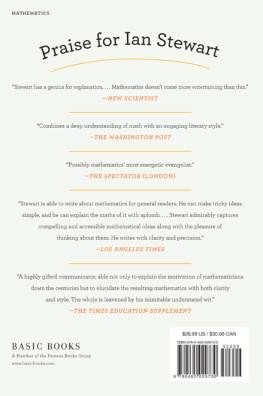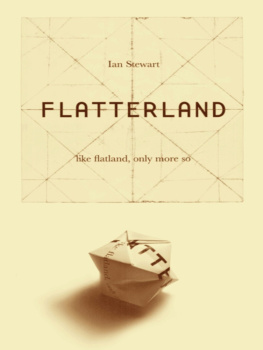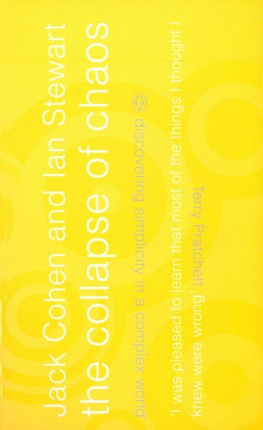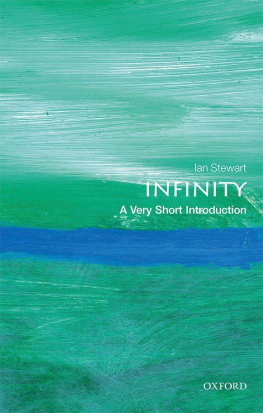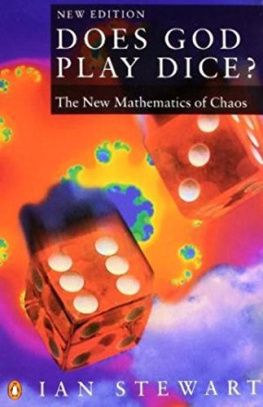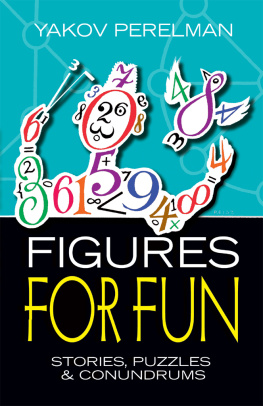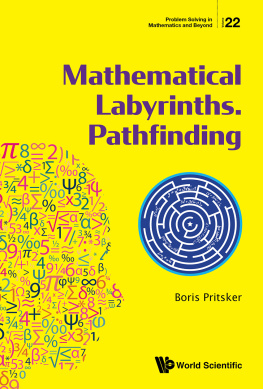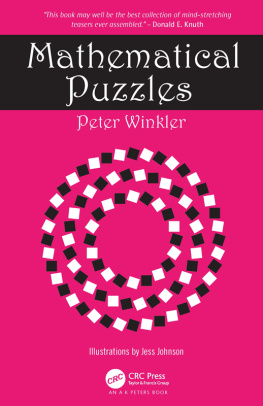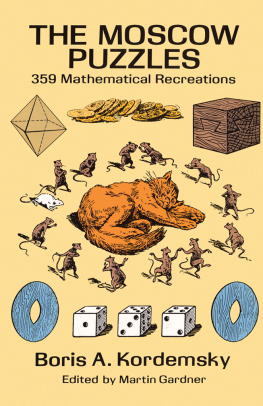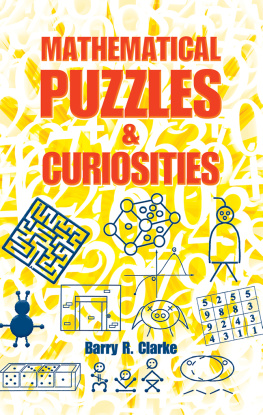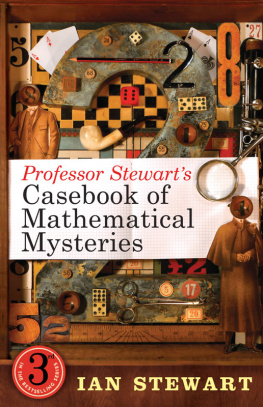Ian Stewart is Professor of Mathematics at Warwick University. An active research mathematician, he is also a world-renowned popularizer of mathematics. He has received numerous awards and honours for his contributions to not only mathematics itself but also to the public understanding of mathematics and related areas of science.
He has written many books including Math Hysteria, From Here to Infinity, Letters to a Young Mathematician, three books in the The Science of Discworld series (with Terry Pratchett and Jack Cohen), Flatterland, Natures Numbers, and Does God Play Dice?
By the same author
Concepts of Modern Mathematics
Game, Set and Math
The Problems of Mathematics
Does God Play Dice?
Another Fine Math Youve Got Me Into
Fearful Symmetry (with Martin Golubitsky)
Natures Numbers
From Here to Infinity
The Magical Maze
Lifes Other Secret
Flatterland
What Shape Is a Snowflake?
The Annotated Flatland
Math Hysteria
The Mayor of Uglyvilles Dilemma
Letters to a Young Mathematician
With Terry Pratchett and Jack Cohen
The Science of Discworld
The Science of Discworld II: The Globe
The Science of Discworld III: Darwins Watch
With Jack Cohen
The Collapse of Chaos
Figments of Reality
Evolving the Alien (alternative title: What Does a Martian Look Like?)
Wheelers (science fiction)
Heaven (science fiction)
How to Cut a Cake
And other mathematical conundrums
IAN STEWART


Great Clarendon Street, Oxford OX2 6DP
Oxford University Press is a department of the University of Oxford.
It furthers the Universitys objective of excellence in research, scholarship,
and education by publishing worldwide in
Oxford New York
Auckland Cape Town Dar es Salaam Hong Kong Karachi
Kuala Lumpur Madrid Melbourne Mexico City Nairobi
New Delhi Shanghai Taipei Toronto
With offices in
Argentina Austria Brazil Chile Czech Republic France Greece
Guatemala Hungary Italy Japan Poland Portugal Singapore
South Korea Switzerland Thailand Turkey Ukraine Vietnam
Oxford is a registered trade mark of Oxford University Press
in the UK and in certain other countries
Published in the United States by
Oxford University Press Inc., New York
Joat Enterprises, 2006
The moral rights of the author have been asserted
Database right Oxford University Press (maker)
First published 2006
All rights reserved. No part of this publication may be reproduced,
stored in a retrieval system, or transmitted, in any form or by any means,
without the prior permission in writing of Oxford University Press,
or as expressly permitted by law, or under terms agreed with the appropriate
reprographics rights organization. Enquiries concerning reproduction
outside the scope of the above should be sent to the Rights Department,
Oxford University Press, at the address above
You must not circulate this book in any other binding or cover
and you must impose this same condition on any acquirer
British Library Cataloguing in Publication Data
Data available
Library of Congress Cataloging in Publication Data
Data available
Typeset by RefineCatch Limited, Bungay, Suffolk
Printed in Great Britain
on acid-free paper by
Clays Ltd., St Ives plc
ISBN 0199205906 (Pbk.) 9780199205905 (Pbk.)
1 3 5 7 9 10 8 6 4 2
Contents
Preface
Occasionally, when I am feeling unusually relaxed and my mind starts to wander, I wonder what the world would be like if everyone enjoyed mathematics as much as I do. Television news would lead with the latest theorems in algebraic topology instead of tawdry political scandals, teenagers would download Top of the Theorems to their iPods, and calypso singers (remember them?) would strum their guitars to the tune of Lemma Three Which reminds me that the folk-singer Stan Kelly (now Stan Kelly-Bootle, look him up on Google) actually wrote just such a song, back in the late 1960s when he was studying for a mathematics MSc at the University of Warwick. It began:
Lemma three, very pretty, and the converse pretty too,
But only God and Fermat know which one of them is true.
Anyway, I have generally viewed maths as a source of inspiration and enjoyment. I am aware that in most people what it inspires is sheer terror, not fun, but I find it impossible to share that view. Rationally, I understand some of the reasons for the widespread fear of mathematics: there is nothing worse than a subject that absolutely demands accuracy and precision when you are hoping to talk your way out of trouble with a couple of buzzwords and a large dose of effrontery. But emotionally, I find it hard to understand why a subject so vital to the world we inhabit, with such a long and absorbing history, littered with the most brilliant insights ever made by human beings, can fail to intrigue and fascinate.
On the other hand, bird-watchers also find it hard to appreciate why the rest of the world does not share their passion for ticking off entries on lists. My god, is that the mating plumage of the lesser-crested nitwit? The last one recorded in Britain was sighted on the Isle of Skye in 1843, and that one was partially hidden behind a oh, no, its just a starling with mud on its tail. No offence intended I collect rocks. Wow! Genuine Aswan granite! Our house is filling up with pieces of the planet.
It probably doesnt help that what most people mean by the word mathematics is routine arithmetic. Thats fun, in a nerdy sort of way, if you can do it. Its horrible if you cant. Moreover, it is very difficult to have fun with something be it maths or bird-watching if somebody is standing over you with a big red pen in hand, just waiting for you to make some minor slip so that they can jump in and scrawl all over it. (I mean this metaphorically. It used to be literal.) After all, whats a decimal point or two between friends? But somewhere in the gap between the National Curriculum and Young Henrys grasp of it, a lot of the fun of mathematics seems to have gone the way of the Dodo. Which is a pity.
Im not claiming that How to Cut a Cake will have a dramatic effect on the mathematical abilities of the general public, though I suppose it might. (In which direction ah, thats another matter.) What Im trying to do here is mostly to preach to the converted. This is a book for the fans, for the enthusiasts, for the people who actively like mathematics, and who retain a sufficiently youthful mind that they can gain a lot of pleasure through play. The air of frivolity is reinforced by Spike Gerrells delightful cartoons, which capture the spirit of the discussion perfectly.
The intent, however, is deadly serious.
I actually wanted to call the book Weapons of Math Distraction, which to my mind had exactly that balance of seriousness and frivolity, so I should probably be grateful for the marketing departments veto. But with its practical cake-oriented title there is a danger that some of you may be thinking of buying this book to obtain some serious culinary instruction. Whence this disclaimer: this is a book about puzzles and games of a mathematical nature, not about cookery. The cake is actually a Borel measure space.
Heavily disguised as a cake. And what mathematics teaches us is not how to cook it, but how to divide it fairly among any number of people. And which is much harder without creating envy. Cake-cutting provides a simple introduction to mathematical theories of sharing resources. Like most introductory mathematics, it is what the professionals like to call a toy model, drastically simplified from anything in the real world. But it gets you thinking about some key issues. For example, it makes it obvious that it is
Next page

